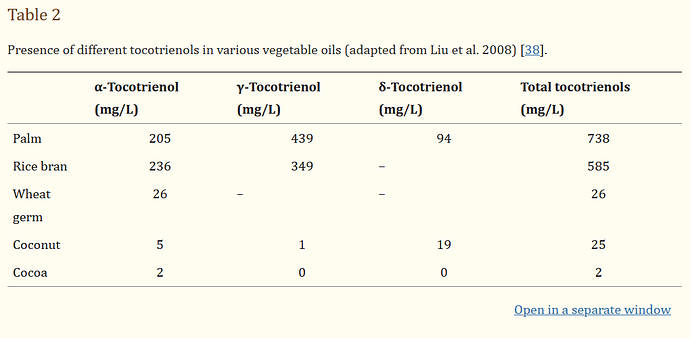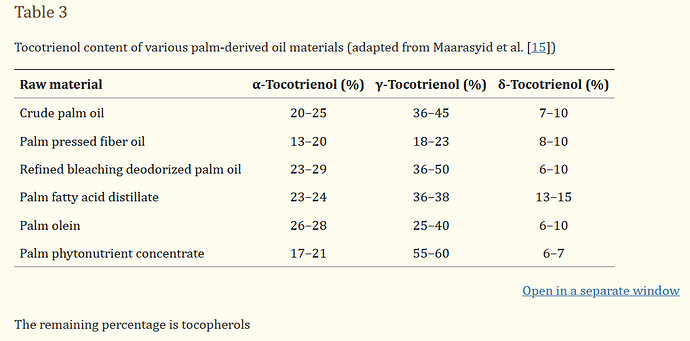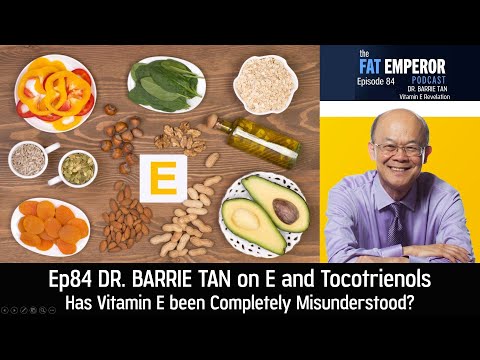Anyone using Tocotrienols?
I think that rapamycin is probably a much more powerful anti-inflammatory and I’m not persuaded that the benefits of Vitamin E, etc. are significant enough to worry about supplementing with…
From Mayo Clinic:
Most people get enough vitamin E from a balanced diet. If you’ve been diagnosed with mild to moderate Alzheimer’s disease, some research suggests that vitamin E therapy might help slow disease progression.
However, oral use of vitamin E might increase the risk of prostate cancer. Use of the supplement can pose other serious risks, particularly at high doses and if you have other health conditions or have had a heart attack or stroke.
and there are associations with cancer - pro and con:
Yes, for a couple of years I’ve been taking between 50mg and 150mg/day.
Tocotrienols, specifically δ-Tocotrienol{delta-Tocotrienol] is not the conventional Vitamin E.
δ-Tocotrienol, with quercetin and fisetin as a senolytic.
FWIW a quick review and references;
I was totally into tocotrienols at one time but here’s my concern. High fat diets are associated with activating PPAR delta which accelerates the conversion of pre cancerous pancreatic lesions into full blown cancer.
Unfortunately, the delta form of tocotrienols also upregulates PPAR delta. See under the lipid peroxidation section:
If you find a pure gamma form free of tocopherols, that might be a winner.
Here are my highlight notes from the cited summary of research abstracts on tocotrienols (T3): “Tocotrienols-- Anti-Aging and Senolytic Properties”
- The vitamin E family comprise four (unsaturated) tocotrienols (T3) (alpha, beta, gamma, delta) and four (saturated) tocopherols (alpha, beta, gamma, delta)
- T3 is bioavailable, particularly when taken with food, but it varies by individual
- demonstrated benefits: amelioration of lipid profile, the promotion of Nrf2 mediated cytoprotective activity and the suppression of inflammation; possibly due to suppressing SASP
- like quercetin, T3 promotes apoptosis in a multitude of cancer lines and has rejuvenating effects in senescent cells
- T3 potentially modulates replicative senescence of myoblasts
- T3 exerts a significant antitumor activity in a wide range of cancer cells, particularly cancer stem cells
Now let’s dig into some of this other research
The article didn’t distinguish between the various forms of vitamin E, and basically called for caution while not saying much definitively, which is probably the state of research:
- mixed evidence on helping with Alzheimer’s disease
- might improve symptoms of nonalcoholic fatty liver disease, but, taken for this purpose, might increase insulin resistance
- might increase the risk of prostate cancer
- might increase your risk of bleeding, so stop 2 weeks before surgery
- might (or might not) increase Cytochrome P450 3A4 (CYP3A4)
This paper is on the tocopherol forms of vitamin E and cancer. Key conclusion:
At the supra-nutritional levels, however, γ-T and δ-T are cancer preventive, but α-T is not effective.
Tocotrienol is a cardioprotective agent against ageing-associated…
tocotrienols have been shown to be important in activating PPAR family of nuclear receptors, namely PPARα, PPARγ and PPARδ
δ-tocotrienol is becoming regarded as the homologue with strongest activity amongst tocotrienols where lipid peroxidation inhibition is concerned
I couldn’t find a reference in the paper to δ-tocotrienol as being most potent form in increasing the activity of PPARδ
In paragraph 5 under lipid peroxidation they reference that tocotrienols activate all 3 PPAR’s.
I researched elsewhere to find that the gamma tocotrienols only upregulate alpha PPAR. That should be ok. I think astaxanthin is the same .
This an older study 2003, attached is a PDF copy.
“Nitric oxide synthase activity in blood vessels of spontaneously hypertensive rats: antioxidant protection by gamma-tocotrienol.”
Nitric oxide synthase activity in blood vessels - 2003.pdf (184.5 KB)
gamma-tocotrienols seem to be the most effective variety for lowering cholesterol too:
gamma-tocotrienol is a more potent agent than a mixture of tocotrienols.
Unfortunately, some commercial mixes don’t say the proportion, and others are 85% delta, like this one derived from annantto:
But, in general, gamma is probably going to dominate:
with palm (and perhaps other sources), the % can vary by the exact form of the source:
FWIW…The major manufacture{a real manufacturer not a marking company] of “Vitamin E” is A.C. Grace Company.
Do you know of a particular brand that is gamma? I’d definitely be interested.
I’ve been taking this for the last few years.
From their Q&A section: it looks like a typical mix, totaling 56mg T3. Its source product is not shown.
Merchant Response
We greatly appreciate your feedback! The “Mixed tocotrienols/tocopherol complex” yields 25-34 mg Gamma tocotrienol, 17-22 mg Alpha tocotrienol, 10-15 mg Delta tocotrienol, 2 mg Beta tocotrienol, and 13-19 mg Alpha tocopherol.
Kudos to the merchant for responding.
I am interested in taking more of my Astaxanthin supplement but have found Natural Tocopherols as an ingredient. I am worried that I may be taking too many tocopherols to get the amount of astaxanthin I want. Does anyone know a way around this???


